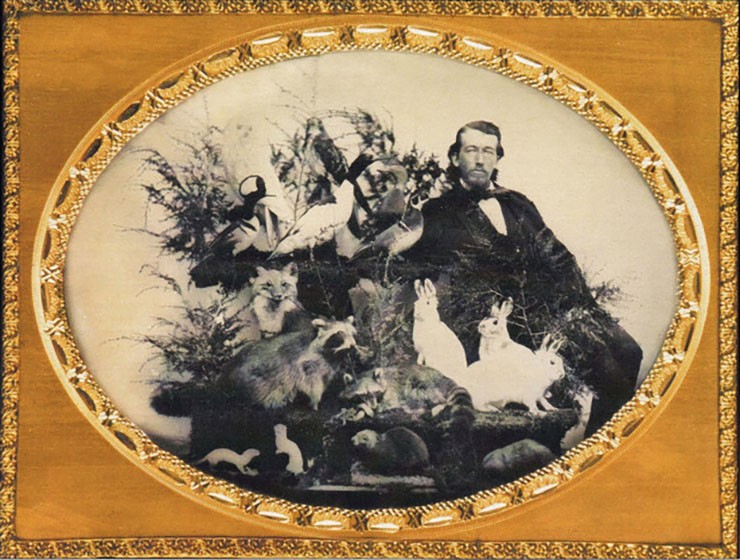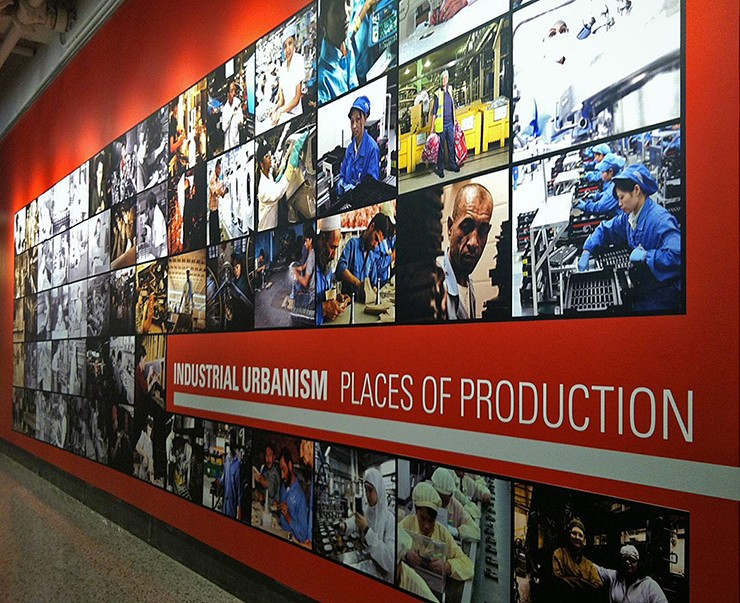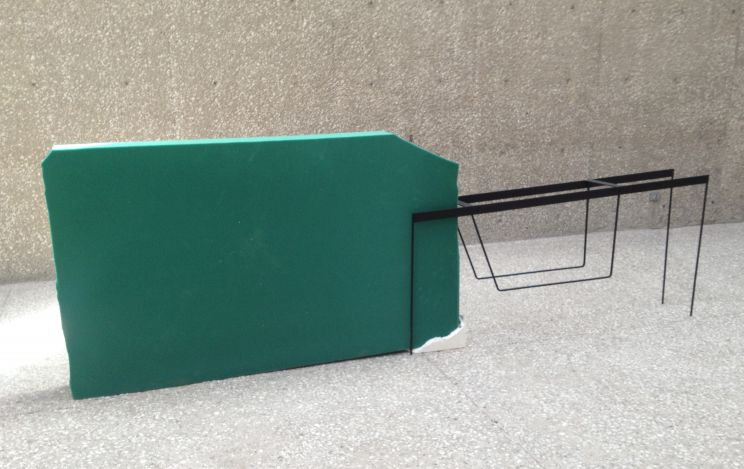Thea Djordjadze
List Visual Arts Center, October 10, 2014 – January 4, 2015
Combining traditional materials of sculpture such as plaster and wood with everyday objects like foam and linoleum, Thea Djordjadze (born 1971, Tbilisi, Georgia) creates installations of sculptural objects that are sited to respond to one another and the space of their installation. Her work is characterized by tensions between materials and forms. Geometric constructions drawn from modernist architecture and design are exhibited together with clay sculptures and carpets that reveal their status as handmade. Her use of linoleum—an inexpensive floor covering widely used for kitchen floors in the early 20th century—further brings a sense of domesticity to the museum. Djordjadze’s work often gestures towards exhibition furniture, including plinths and vitrines, while simultaneously upending the conventions of museum display, such as when a foam slab approximating the dimensions of a mattress is displayed on its side supported by a thin steel structure.

Open Tunings
List Visual Arts Center, October 10, 2014 – January 4, 2015
Although sound art’s pedigree goes back to the pre-war avant-garde experiments of Futurism and Dada, it has until very recently received sporadic attention in museum and gallery exhibitions. Inherently about time and change, invisible and uncontainable, sound is in fact in some ways antithetical to conventional forms of display. Sound is also interdisciplinary: It overlaps withboth the performing arts, including experimental music, and the visual arts,where sound art emerged more fully in the 1960s alongside a range of other process-based forms including body and land art, video and film.
Open Tunings seeks to provide an experimental platform to explore the various ways in which the ephemeral forms of sound and performance can inhabit the exhibition space. Borrowing its title from a guitar technique by which the instrument is tuned to be strummed with “open,” that is unfretted, strings, this exhibition will present three consecutive, changing installations in sound and brings together David Grubbs & Eli Keszler, Brendan Fowler, and Hannah Weinberger. Each project was conceived for the exhibition and takes its point of departure from a performance in the List’s Reference Gallery, followed by the presentation of audio or video recordings or objects used during the event. In both live and ongoing formats, the works variously examine the relationships between architectural space and spatial sound, presence and absence, liveness and recording, improvisation and script.

5,000 Moving Parts
MIT Museum, November 21, 2013 through January 19, 2015
Melding art, science, history and technology, 5000 Moving Parts features sculptures by Anne Lilly, John Douglas Powers, Takis, Rafael Lozano-Hemmer and Arthur Ganson in collaboration with sound artist Christina Campanella. The exhibition looks at the wide range of kinetic art being made now: from work that’s concerned entirely with motion and unpredictability, to sculptures that engage with contemporary political topics, to work that brings ancient myth into contemporary life.

Daguerre’s American Legacy: Photographic Portraits (1840-1900) from the Wm. B. Becker Collection
MIT Museum, April 18, 2014 – January 4, 2015
Provocative, thoughtful and sometimes haunting, the portraits in this exhibition of 19th century Americans portray men, women and children during an era when new photographic technologies were just becoming accessible and popular. On loan from the collection of Wm. B. Becker, a noted collector of early photography, are 170 daguerreotypes, ambrotypes, tintypes and albumen prints, as well as several dozen cameras and other artifacts.

Three Pioneers
MIT Media Lab, June 19 – October 31, 2014
Muriel Cooper, Marvin Minsky, Seymour Papert: each of these three pioneers defied convention, rejected norms, and adored the impossible. Minsky taught us how uncommon common sense was. Papert forced us to think about thinking. And Cooper showed us that the medium was not the message. Without them, the Media Lab would never be what it became.

Producing Subjects
Dean’s Gallery, August 18, 2014 – August 7, 2015
Producing Subjects, drawn from the collection of the List Visual Arts Center, considers a group of works made in the last forty years and looks at how each artist’s process and output engages with material and cognitive labor.
Artists on view: William S. Burroughs, Vija Celmins, Paul Chan, Jim Dine, Peter Fischli & David Weiss, Lee Friedlander, Laura Letinsky, Sol LeWitt, Matt Mullican, Lee Newton, Eduardo Paolozzi, Omar Rayo, Tomás Saraceno, and Andy Warhol.

Industrial Urbanism: Places of Production
Wolk Gallery, September 5 – December 19, 2014
Since the Industrial Revolution, cities and industry have grown and evolved together. Despite this shared past, popular notions of urban industry tend to focus on the negative aspects of manufacturing: pollution, environmental degradation, and the exploitation of labor caused by industry. Industrial Urbanism: Places of Production moves the conversation beyond these overly-simplified and overly-negative characterizations. It explores the relationship between current urban planning practices and the types of places that are actually designed and designated for the production of goods today. In the midst of shifting labor markets, technological changes, and resurgent metropolitan growth, the need to reimagine the role of industry in our cities is greater than ever. The exhibition reexamines how industry can create place, sustain jobs, and promote environmental sustainability, all within the urban fabric. Exhibition Curators: Tali Hatuka, Laboratory for Contemporary Urban Design, Department of Geography and Human Environment, Tel Aviv University. Eran Ben-Joseph, Department of Urban Studies and Planning, School of Architecture + Planning, Massachusetts Institute of Technology.

Wired: A World Transformed by the Telegraph
Maihaugen Gallery (MIT Libraries), September 2 – December 31, 2014
Long before telephone or text, instantaneous messages travelled by telegraph. Explore the historic significance of this technological triumph of the 19th century through an exhibit featuring books, telegrams, photographs, and ephemera from the Libraries’ Peterson Telegraphy Collection.
—
Courtesy the artist and Sprüth Magers Berlin London2. David Grubbs and Eli Keszler. Credit: Christelle Perrin.
3. 5000 Moving Parts (Installation View). Credit: L. Barry Hetherington
4. Courtesy of Wm. B. Becker Collection/American Museum of Photography
5. Seymour Papert, Marvin Minsky and Muriel Cooper. Courtesy of the MIT Media Lab
6. Laura Letinsky, Untitled #49, Chicago from I did not remember I had forgotten, 2002.
7. Industrial Urbanism: Places of Production at the Wolk Gallery. Credit: Judy Daniels
8. Courtesy of MIT Libraries

